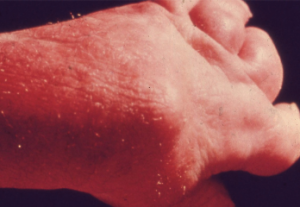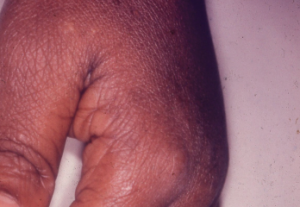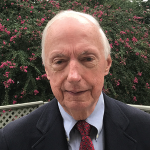
This is one of the very few slides in the first collection that allowed two images. In this case it demonstrates a fortunately now rare manifestation of very severe psoriatic arthritis mutilans, showing in identical poses what the hand looks like to a clinician and the very severe destructive disease seen radiologically. (In the original slide, the radiograph was much clearer. The slide was submitted by E. Carwile LeRoy.)
Dr. Lockshin recalls spending long hours with other committee members debating the merits of slides and working with the Bergmans to make the collection as visually attractive and informative as possible. He praised the Bergmans for their esthetic sense—eliminating extraneous details in photos, such as bedclothing and patient jewelry, to focus on the teaching point—as well as their careful attention to light distribution and tint.
Fulfilling the adage that no good deed goes unpunished—but certainly makes a good story—Dr. Lockshin recalls being “rewarded” for his role in assembling the 1972 collection by being asked to present the collection formally during the 1973 International League Against Rheumatism (ILAR) meeting in Kyoto, Japan. Circumstances led to the ACR financing his travel by designating him the official travel guide to the other Americans traveling to the meeting.

 Joseph Croft, MD, clinical professor of rheumatology at Georgetown University Medical Center and past president of the ACR, overlapped with Dr. Lockshin’s term on the Audiovisual Aids Subcommittee from 1974–88. Dr. Croft served as committee chair from 1975–82.
Joseph Croft, MD, clinical professor of rheumatology at Georgetown University Medical Center and past president of the ACR, overlapped with Dr. Lockshin’s term on the Audiovisual Aids Subcommittee from 1974–88. Dr. Croft served as committee chair from 1975–82.

